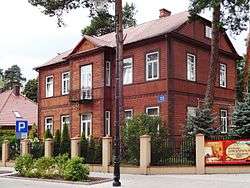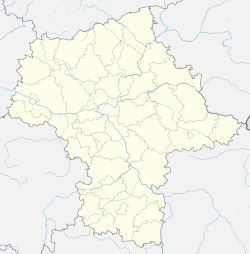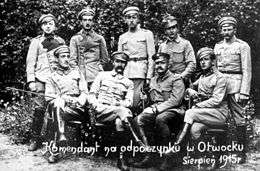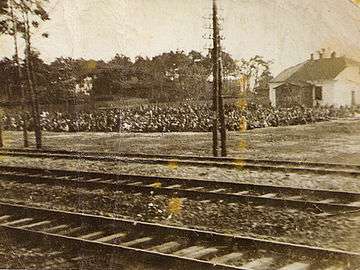Otwock
Otwock [ˈɔtfɔt͡sk] (![]()
Otwock | |
|---|---|
 Świdermajer-styled house in Otwock | |
 Flag  Coat of arms | |
 Otwock  Otwock | |
| Coordinates: 52°7′N 21°16′E | |
| Country | |
| Voivodeship | |
| County | Otwock County |
| Gmina | Otwock (urban gmina) |
| Established | 1877 |
| Town rights | 9 November 1916 |
| Government | |
| • Mayor | Jarosław Margielski (PiS) |
| Area | |
| • Total | 47.33 km2 (18.27 sq mi) |
| Elevation | 100 m (300 ft) |
| Population (2013) | |
| • Total | 45,044 |
| • Density | 950/km2 (2,500/sq mi) |
| Time zone | UTC+1 (CET) |
| • Summer (DST) | UTC+2 (CEST) |
| Postal code | 05-400 to 05-402 |
| Area code(s) | +48 022 |
| Car plates | WOT |
| Website | http://www.otwock.pl |
Otwock is situated in the Masovian Voivodship since 1999; previously, it was in Warszawa Voivodship (1975–1998). It is the capital of Otwock County. The town covers the area of 47 square kilometres (18 sq mi). Forested areas make up 23% of the territory.
History

Even though the first mention of a village called Otwosko comes from the early 15th century, Otwock did not fully develop until the second half of the 19th century, when in 1877 the Vistula River Railroad was opened, which ran from Mława via Warsaw, to Lublin and Chełm. Otwock, which is located along the line, became a popular suburb, with numerous spas and several notable guests, including Józef Piłsudski and Władysław Reymont, who wrote his Nobel prize-winning novel Chłopi there. In 1916, Otwock was incorporated as a town and became the seat of a powiat. In 1936 railway connection Warsaw - Otwock was electrified as the first rail line in Poland.
World War II

Following the Nazi–Soviet Invasion of Poland in December 1939, the German authorities established a Jewish ghetto in Otwock. A murderous Action T4 euthanasia program was carried out by the Nazis in the local Zofiówka Sanatorium for the psychiatric patients[1] in order to confine its Jewish population for the purpose of persecution and exploitation.[2] The Ghetto was liquidated between August and 19 September 1942, when 75% of its Jewish population of 12,000–15,000 numbering at around 8,000 were assembled by the Nazis at a layover yard in Otwock (pictured) and transported in cattle trucks to extermination camps in Treblinka and Auschwitz.[3] Jews who remained were summarily shot at Reymonta Street soon after.[4]
Otwock is the hometown of Irena Sendler (1910 – 2008), the Polish humanitarian who saved thousands of Jewish children during the Holocaust; as well as Krystyna Dańko, both awarded the titles of Righteous among the Nations by Yad Vashem. Writer Calel Perechodnik, a Jewish Ghetto Policeman from Otwock also hailed from this town. Following the liberation, a children's home for Holocaust survivors was established in Otwock.[5]
Economy
In 1958, Ewa, the first Polish nuclear reactor was activated in Swierk district of Otwock. A second research reactor, Maria, was erected in 1974.
Otwock is home to a sports club Start Otwock (founded in 1924). The club is renowned for its weight-lifters such as Szymon Kołecki and Marcin Dołęga. Also, the Start Club's own prodigy is football forward Janusz Żmijewski who in the 1960s played for Legia Warszawa and the national team of Poland.
International relations
See also
- Świdermajer - The characteristic architectural style of the area
References
- The statistical data compiled on the basis of "Glossary of 2,077 Jewish towns in Poland" Archived 8 February 2016 at the Wayback Machine by Virtual Shtetl Museum of the History of the Polish Jews (in English), as well as "Getta Żydowskie," by Gedeon, (in Polish) and "Ghetto List" by Michael Peters at www.deathcamps.org/occupation/ghettolist.htm (in English). Accessed 12 July 2011.
- "The War Against The Jews." The Holocaust Chronicle, 2009. Chicago, Il. Accessed 21 June 2011.
- Sabina Bauman, "Czwarty marsz" (The Fourth March of the Living) Archived 7 October 2011 at the Wayback Machine Linia otwocka 26 September 2005.
- Społeczny Komitet Pamięci Żydów Otwockich i Karczewskich - działania w latach 2002-2007 Archived 30 October 2018 at the Wayback Machine Sekcja terenowa Polskiej Rady Chrześcijan i Żydów (Otwock Branch of Poland’s Advisory of Christians and Jews Archived 9 June 2009 at the Wayback Machine); Zbigniew Nosowski, President. (in Polish)
- A Time to Heal: The Story of the Children's Home in Otwock an online exhibition by Yad Vashem
External links
- (in Polish) Town of Otwock, official website
- (in Polish) Otwock info site including local news
- (in Polish) Młody Otwock - The Young Otwock [organization], Otwock culture. Events
- (in Polish) Otwock Photo Gallery
- (in Polish) Photo gallery
- Jewish Community in Otwock on Virtual Shtetl
- Otwock, Poland at JewishGen
